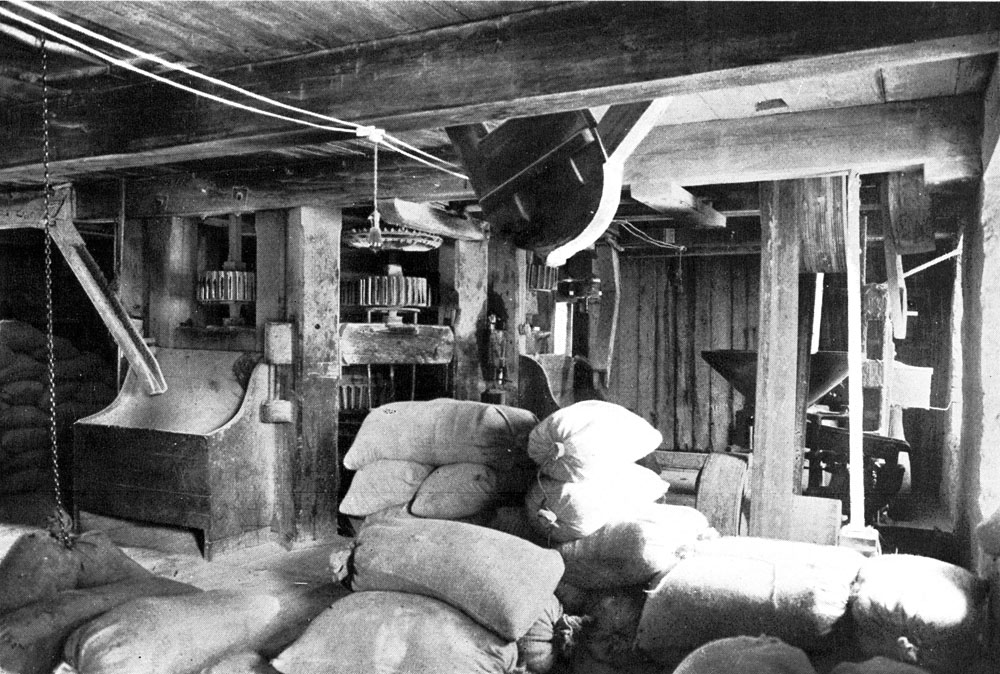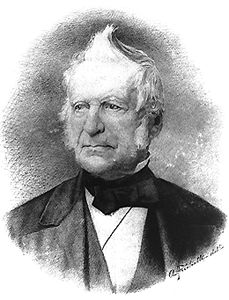The seigneurial system was an institutional form of land distribution established in New France in 1627 and officially abolished in 1854. In New France, 80 per cent of the population lived in rural areas governed by this system of land distribution and occupation. In principle, the seigneur granted a piece of land to a family under a royalty system. The family would engage in subsistence farming to meet most of their food, heating, and shelter needs.
The seigneurial system was based on the feudal system, which involved the personal dependency of censitaires (tenants) on the seigneur. In New France the similarities ended with occupation of land and payment of certain dues. The tenant was normally referred to as a habitant. The Compagnie des Cent-Associés, which was granted ownership and legal and seigneurial rights over New France, from the Arctic to Florida, also obtained the right to allocate the land to its best advantage. The land was therefore granted as fiefs and seigneuries to the most influential colonists who, in turn, granted tenancies.
Systematic Settlement
This politically determined system of land distribution was regulated by law and had many advantages. Its purpose was to promote settlement in a systematic way. Seigneuries, which were usually 1 x 3 leagues (5 x 15 km) in size, were generally divided into river lots (rangs), a survey system based on the French experience in Normandy. The long, rectangular strips were particularly well adapted to the local terrain, since they facilitated interaction between neighbours and provided multiple points of access to the river, the principal communication route. Individual holdings were large enough (usually about 3 x 30 arpents) to provide a reasonable living to farmers. The state established regulations to govern the system and the relationship between seigneurs and their tenants. The principal regulation granted a person, who thus became seigneur, a parcel of land that was to put into production, either directly or through concession to habitants who requested land. Portions of the seigneur's land were usually leased on the basis of a duly notarized contract. These acts of concession set out the rights and obligations of each party.
The seigneur had both onerous and honorary rights. He could establish a court of law, operate a mill and organize a commune. He received from the habitants various forms of rent: the cens, a small tithe dating from the feudal period, which reaffirmed the tenant's theoretical subjection to the seigneur; the rente in cash or kind; and the banalités, taxes levied on grain, which the tenant had to grind at his seigneur's mill. He also usually granted hunting, fishing and woodcutting licences. In the early 18th century, seigneurs began to insist that their tenants work for them a certain number of days annually (see Corvée).
Social Hierarchy and Inequality
The seigneurial system is often presented as a basic form of land distribution and occupation. However, recent studies have called for a re-evaluation of this traditional interpretation and have highlighted an aspect of the seigneurial system that is often neglected. As an institution, the seigneurial system played a leading role in building and maintaining social relations in New France. According to some historians, it represents [translation] “the essence of the social hierarchy and inequality that characterized pre-revolutionary France.” Whether they were of noble or common descent, the seigneurs were a privileged class, and their relationships with the censitaires were affected by the perception of the cens. However, this is not to suggest that the seigneur oppressed the censitaire. The availability of land in the 17th and 18th centuries allowed habitants to choose where to settle. Furthermore, seigneurs who were too demanding, who were absentee landowners, or who neglected to develop their lands were less likely to attract settlers.
Major Role
The seigneurial system was central to France's colonization policy and came to play a major role in traditional Québec society. Despite the attractions of city life and the fur trade, 75 to 80 per cent of the population lived on seigneurial land until the mid-19th century. Roughly 220 seigneuries were granted during the French regime. They covered virtually all the inhabited areas (36,500 km²) on both banks of the St. Lawrence River between Montréal and Québec City and the Chaudière and Richelieu Valleys and extended to the Gaspé Peninsula. Seigneuries were granted to the nobility, to religious institutions (in return for education and hospital services), to military officers and to civil administrators. Other institutional organizations such as parishes, municipalities and the militia held land bordering on these seigneuries.
This method of land settlement left its mark on both the countryside and the Québec mentality. The land of the habitant was a kind of economic unit essential for survival. Everyone hoped to be the sole tenant, producing most of what he required in order to live. The system of land tenure, which placed rural inhabitants close to one another, and in the early 19th century the village, were the foundation upon which the family, neighbour relations and community spirit developed. The closeness of this agricultural society to the soil led naturally to a feeling that land was included in one's patrimony, to be passed from generation to generation.
Development of Town System
After Canada was ceded to Britain in 1763 (see Treaty of Paris), new British laws respected the private agreements and the property rights of francophone society, and the seigneurial system was maintained. But as new land was opened for colonization, the township system developed. As time went on, the seigneurial system increasingly appeared to favour the privileged and to hinder economic development. After much political agitation, it was abolished in 1854 by a law that permitted tenants to claim rights to their land. The last vestiges of this institution, which many historians believe profoundly influenced traditional Québec society, did not disappear until a century later.
Censitaires who were unable to pay back the capital of their rentes would be obliged to make annual royalty payments called rentes constituées, which were payable in perpetuity. Every year on St. Martin’s Day (11 November), censitaires would present themselves at the seigneurial manor to pay their rentes. While the Seigniorial Act of 1854 abolished the system of rights and obligations, neither seigneurial property nor the relationship between seigneur and censitaire was abolished. In 1928, an inquiry launched by the Bureau de la statistique du Québec (Statistics Québec) showed that rentes were still being collected in 190 seigneuries (for a total capital value of $3,577,573). The annual payments made by nearly 60,000 families amounted to more than $200,000.
In 1935, the Québec government created the Syndicat national du rachat des rentes seigneuriales, or SNRRS (National Commission for the Repurchase of Seigneurial Rentes), in an effort to put an end to the seigneurial system once and for all. Its mandate was to make, on behalf of independent cities and towns and county councils, the final payments of rentes constituées to those who held seigneurial rights over their land. To achieve this, the SNRRS took out a government-secured loan and became the creditor for several municipalities in Québec. In exchange, these municipalities were required to create a special tax roll that would establish the amount of each censitaire’s annual payment to the SNRRS in addition to property taxes. The amount received was then transferred to the SNRRS to be used to repay the loan over a 41-year period. The last payment made by the municipalities to the SNRRS was in 1970. Some censitaires paid this municipal “tax,” established to replace the former system of the rente constituée, over a period of 30 years.
In short, the impact and importance of the seigneurial system goes beyond landscape and toponymy (see Place names). It left an important mark on the history of some municipalities in Québec. Some former seigneurs played central roles in municipal politics and became the first mayors of their localities. Furthermore, some seigneurial families continue to be remembered in Québec. For example, in the 20th century, several seigneurial honours were bestowed on descendants of seigneurial families, including Pierre Boucher of Boucherville, who was interred beneath the Sainte-Famille church in Boucherville in 1957. Perceptions of the Tessier family of Beauport and the Taschereau family of Sainte-Marie de Beauce are influenced by their ties to the seigneurial system.

 Share on Facebook
Share on Facebook Share on X
Share on X Share by Email
Share by Email Share on Google Classroom
Share on Google Classroom















